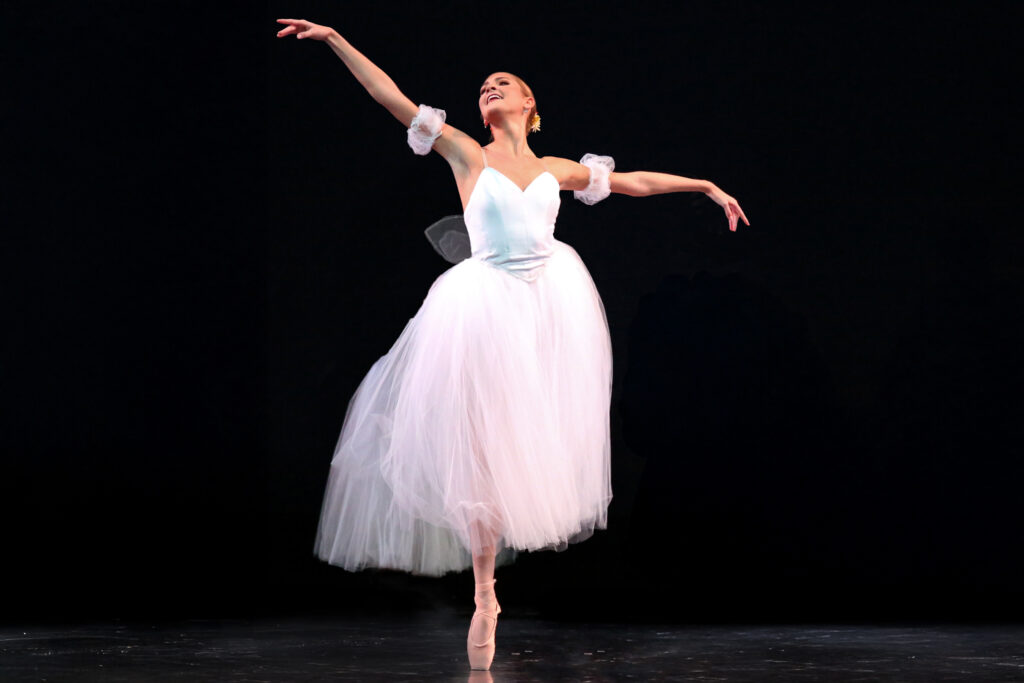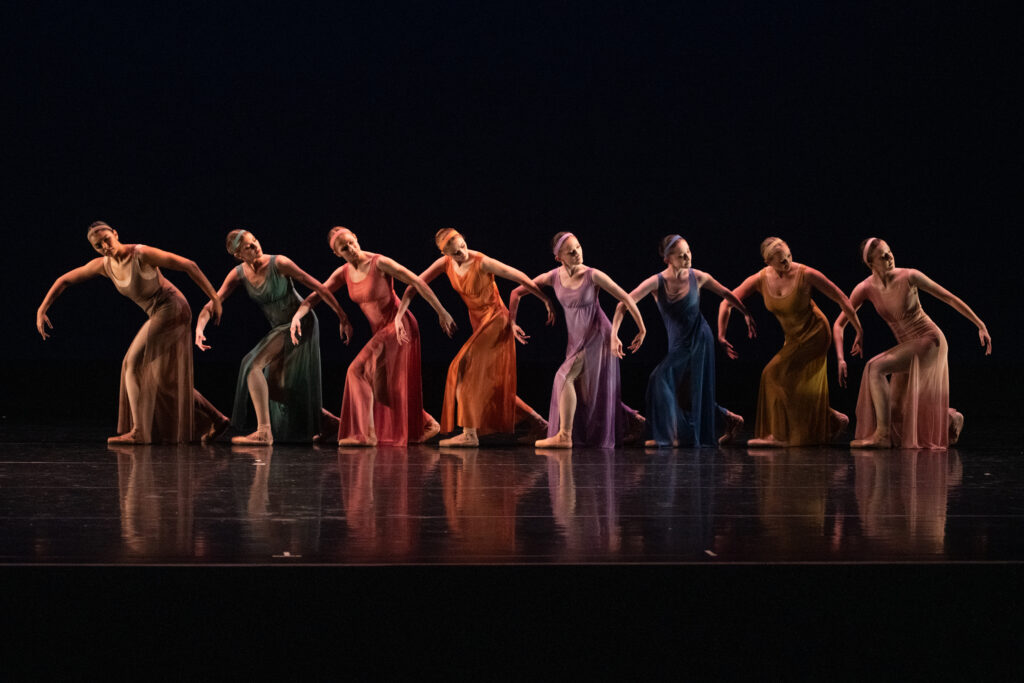Next spring, Mia Sanderson will graduate from University of South Carolina’s Betsy Blackmon Dance Program with two degrees, completing four years of dance and advertising curriculums that now position her for several career options: Will it be professional company life or marketing for a dance organization? Maybe even musical theater, she says.
“I’ve definitely become a better version of myself,” Sanderson says as she considers the education that brought her to this point. “I’m just going to see where the world takes me.”

Sanderson’s enviable flexibility is the result of professors like Jennifer DeckertUSC’s dance program director, who has never been interested in teaching a narrow path to success. “It’s about way more than their passion for dance,” she says. “It’s their passions for life.”
Prepping for the Stage, the Classroom, and Beyond
Deckert structures USC’s program with this in mind, and the school offers two BA tracks: Performance & Choreographywhich supports double majors like Sanderson’s, and Dance Educationwhich allows students to graduate with a K–12 teaching certificate. The latter nearly guarantees employment in the state of South Carolina, and makes getting a dance education position in another state much simpler. In addition, the program recently added a low-residency MA in Dance Studies, the first graduate program in dance in the state of South Carolina designed for working professionals.
 A dance student rehearses in one of USC’s spacious, state-of-the-art dance studios. Photo by Jason Ayer, courtesy University of South Carolina.
A dance student rehearses in one of USC’s spacious, state-of-the-art dance studios. Photo by Jason Ayer, courtesy University of South Carolina.
“There are more avenues than a performance life,” Deckert says. Alongside the BA in Dance with an emphasis in Performance & Choreography, “there are degrees students can seek that will support them and continue to serve the dance community—that may or may not be them continuing to perform full-time, but (they) are still integrated into our dance world.” Common second majors or minors include Business, Political Science, Journalism, Media Arts, Pre-Med, Pre-Physical Therapy, Marketing, Biology, History, and Psychology.
A Classical Foundation, With Room for Play
The variety of options should not, however, be misconstrued for a lack of quality or intensity. USC’s program is classically focused: Students take ballet four days a week and contemporary twice a week, supplemented with additional options like pointe, jazz, and West African dance.
“They usually come to our dance building around 11 am every day, and then they’re in rehearsals until about 5 pm,” Deckert says. Evenings remain open to allow opportunities for enrichment beyond the studio or stage—dance students are encouraged to attend sporting events, join Greek life, and expand their social and academic circles throughout the city of Columbia.
 USC’s Betsy Blackmon Dance Company performs the classic Michel Fokine ballet
USC’s Betsy Blackmon Dance Company performs the classic Michel Fokine ballet
Les Sylphides. Photo by Sadie Whitehead, courtesy University of South Carolina.
“Part of the reason why I chose USC is because it’s in the South,” says Sanderson, who’s originally from Minnesota. “I felt like if I had gone to another school, I wouldn’t have gotten as much of an idea of the types of people that we live in the world with. It’s really important to know that as an artist.”
Coming This Spring: The Joffrey Ballet in Residency
This level of engagement has also attracted industry leaders for on-campus residencies. Spring 2025 will include a three-week visit by Chicago’s Joffrey Ballet, during which choreographer and rehearsal director Nicolas Blanc will create an original work on the company. Meanwhile, Betsy Blackmon Dance Company members will immerse themselves into The Joffrey Ballet’s creative ethos: Gerald Arpino stagers will set historic choreography on the students, and they’ll also learn a contemporary work created by a Joffrey company member.
“It’s the foundation for something really special,” says Catherine Eby, company manager of The Joffrey Ballet. “It’s so exciting for students to have that opportunity to have insight into professional work.”
The residency will be Joffrey’s most extensive collaboration of its kind, resulting in a well-rounded performance slate of dance on campus: The company will present Blanc’s original work and several pieces from its repertoire, and the students will perform two Arpino works and the contemporary piece. Additionally, Joffrey’s music director, Scott Speck, will work with the USC Symphony Orchestra prior to performances directed by USC professor of music Scott Weiss. Throughout the residency, dancers will be able to take company class and observe The Joffrey Ballet in rehearsal. The company’s community engagement director will also join the group in South Carolina and oversee a week of arts programming for community members across campus and throughout the state.
Eby says the enthusiasm and curiosity of USC’s students and faculty was what made agreeing to the residency a no-brainer. “It’s not about where the school is,” she says. The question is “Is the faculty committed and excited to bring these kinds of opportunities, and are the students excited to have this opportunity? Both of those things are abundantly true at USC.”
 USC’s Betsy Blackmon Dance Company performs Essence de Femme, an original work created for the university by Complexions Contemporary Ballet’s Larissa Gerszke utilizing choreography by Complexions co-founder Dwight Rhoden. Photo by Sadie Whitehead, courtesy University of South Carolina.
USC’s Betsy Blackmon Dance Company performs Essence de Femme, an original work created for the university by Complexions Contemporary Ballet’s Larissa Gerszke utilizing choreography by Complexions co-founder Dwight Rhoden. Photo by Sadie Whitehead, courtesy University of South Carolina.
Honoring the Legacy of Betsy Blackmon
The high quality of resources and engagement that attract companies like Joffrey are thanks in part to Tom and Jane Suggs. Last year, the couple made a donation in memory of their daughter, Betsy Blackmon, a beloved class of 2007 graduate who died of cancer in 2018. The newly renamed Betsy Blackmon Dance Program means greater support for students and funding for full-time faculty, guest artists, and state-of-the-art facilities.
“It’s been such an honor to have Betsy’s name connected to our program,” Deckert says. “We expect that it will continue to grow and support our dancers as they get this full experience at USC.”
Audition Now, Then Chart Your Own Course
Interested applicants can find details about auditions—which are submitted via video only—here. Deckert encourages students to apply no matter their background. “We’re looking for dancers that have strong technique and a broad understanding of their bodies. Then we can help refine those skills and abilities in a variety of directions,” she says.
 USC’s Betsy Blackmon Dance Company performs Jerome Robbins’ iconic
USC’s Betsy Blackmon Dance Company performs Jerome Robbins’ iconic
Antique Epigraphs (staged by former New York City Ballet principal dancer Jenifer Ringer). Photo by Jason Ayer, courtesy University of South Carolina.
Sanderson says it’s actually better if you don’t know which direction is yours yet. “A lot of high school students go into their four years of college and they expect to become an older version of this person that they are as a senior in high school,” she says. “But when you’re taking so many classes and interacting with so many different people from different places, it creates a new version of yourself.” She’s excited and curious to find out what comes next.




GIPHY App Key not set. Please check settings